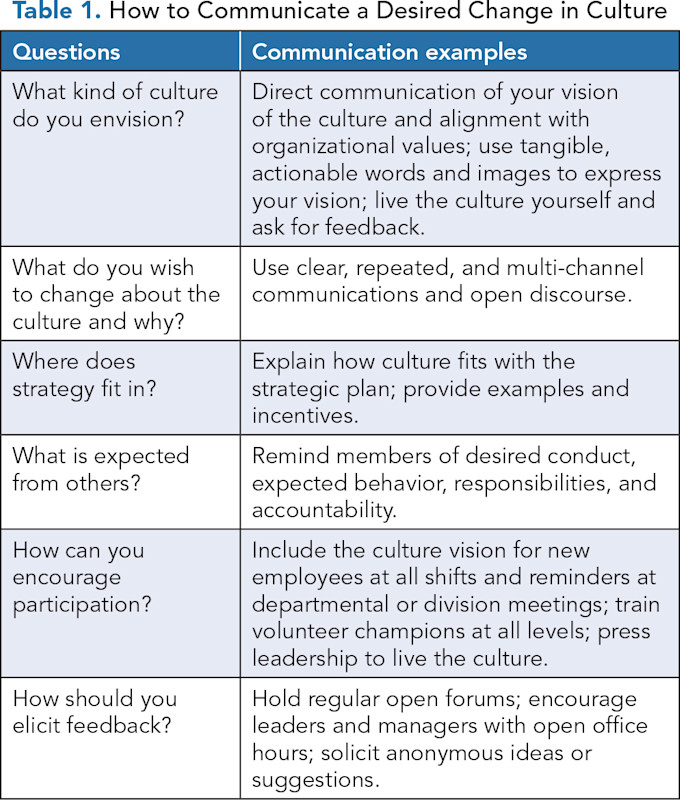“Communication is culture, and culture is communication.”
— Edward Twitchell Hall, anthropologist and cross-cultural researcher
Culture has been informally defined as “the way we do things around here.”(1) For physicians in a healthcare organization, culture is what they see and experience as related to values, behaviors, and policies, whether formal or informal.
Organizational culture is fluid and transforming in response to internal influences and external forces. It is the accumulation of norms communicated over time through many leadership changes. It is dynamic and influenced by socioeconomic factors and new communication methods and styles.(2)
All organizations adjust to a changing environment by learning and adapting to varying norms. However, organizations are made up of people. To change culture, organizational leaders must effectively communicate the desired change to those within the organization.
Communication and culture are interdependent; effective communication, or lack thereof, shapes the culture. Conway and colleagues described culture as a “set of beliefs, customs, symbols, or characteristics that is shared by one population of people and is different from the set of beliefs, customs, symbols, or characteristics shared by other distinct populations.”(3) This is an important observation because most people embedded within an organization may have trouble defining their culture until they encounter one that is different. It is also true that “one size fits all” communication methods or processes may not be appropriate for all organizational cultures.
If a leader’s objective is to assess and change some aspects of organizational culture, communication is a critical part of the toolkit to execute the change. Robert Ford, a senior director of core services engineering for Microsoft, explains that to manage sustainable change successfully, leaders need to know how to communicate purposeful, authentic, and inspirational messages.(4) This is possible only through the right communication channels, consistent with organizational goals.
Although culture change may be the objective, Ford notes that faulty communication from leadership can result in “churn” rather than a real change. He also points to poor or substandard communication, rather than bad ideas or faulty execution of these plans by leaders, as a major reason for the frequent changes in strategic plans in organizations and the failure to change the culture.
STRATEGIES FOR SUCCESSFULLY COMMUNICATING YOUR CULTURE
Because organizational culture tends to be driven from the top, leaders and managers in healthcare systems should be proficient in communication strategies. However, a Gallup survey reports that only 13% of employees believe that their leaders communicate with them effectively.(5) If that is true, what communication strategies should a new leader adopt to change an organization’s culture? Table 1 offers suggestions.

Because one-third of employees appear dissatisfied with their workplace culture as the new leader is looking to “re-set” the existing culture, it is important to decide if the previous organizational strategy, mission, vision, values, behaviors, and incentives should be revamped or replaced. Leadership must then integrate communication strategies to announce the changes within overall strategic planning, not as an afterthought.(6) This allows senior leaders and managers to understand the messaging, its channels, and subgroups.
Communication from leadership provides a “line of sight” from the top to the bottom of the organization so that the messaging is clear, authentic, and positive.(4) It is also necessary to engage other leaders and employees in the desired changes and communicate the case before implementing them. Communication strategies also help leaders and managers implement the changes, follow behaviors, and plan for proper incentives or rewards.
Simply replacing a small number of senior leaders to implement culture change will likely be ineffective. Although these leaders may have contributed to the culture in a uniquely personal manner, most of these norms were probably communicated over time through previous interpersonal interactions. Changing an existing culture, especially in large organizations, takes focused and sustained communication directed at various subcultures over time.
TARGETING SUBGROUPS WITHIN THE ORGANIZATION
Healthcare organizations comprise various subgroups with a common mission, vision, and set of values, but possibly in different geographic areas or specialties.(7) Leaders attempting to take the existing culture in a different direction must direct their communication to three subcultures or groups within organizations(7):
The operator group comprises most of the workers and the managers who supervise them. In healthcare organizations, this group includes physicians, nurses, and technologists. Communication with this group within a healthcare organization is generally focused on patient safety, quality standards, and outcomes.
The engineer group consists of technical experts and includes programmers, financial experts, and information technology workers invested in emphasizing technical expertise. In addition to their new metrics, communications to this group may include sharing changes in their vital role in supporting the clinical efforts to achieve quality and safety goals.
The executive class focuses on productivity and outcomes rather than human needs and behaviors.
Leaders must communicate a consistent message using the language and tools that make sense for each subgroup in the existing culture. Some cultures rely heavily on symbolic communication, such as objects, gestures, and drawings, in contrast to spoken or written modes of communication. Grammar and style may differ based on the genders of the subgroup’s members.(8)
In a diverse population, communication methods require cultural sensitivity. For instance, personal achievement is important in individualistic cultures, including Western cultures, whereas collective cultures, such as Asian cultures, emphasize cooperation and harmony. Communication methods and styles should be adapted to achieve an impact in these subcultural groups.(9) In healthcare organizations, members should participate in training to better understand their own and others’ belief systems to provide culturally appropriate care.
FOUR CONDITIONS OF SUCCESSFUL COMMUNICATION
A culture that lacks open and honest communication hurts employee morale. A positive communication culture is more efficient and productive and is associated with a lower attrition rate. Effective communication can lead to powerful advocates and champions within the desired organizational culture.
Nordby suggests that four conditions must be met for successful communication(10):
First, the communicator must have the audience’s attention, and the audience must process the message rather than just receive it.
Second, the message must be in a shared language. In other words, both sides must have a similar understanding of verbal or nonverbal expressions. Nonverbal messaging can be through body language, gestures, manners, or the written word. Today, instant modes of communication such as text messaging or tweeting may significantly influence culture because of the decrease in verbal communication.
Third, the communicator must ensure that the context of a conversation is not misunderstood or misinterpreted. Nordby provides the example of a manager suggesting that the employee “look into” an issue with the intent that the employee actively investigate the matter. However, the listener may understand “look into” as a voluntary and informal directive.(10) The leader can avoid misunderstandings by being specific rather than vague, time-oriented rather than open-ended, and setting clear expectations.
Fourth, Norby suggests the communicator must consider the relational aspect of communication. The communicator is attempting to convey “attitudes, preferences, and values,” but this is only successful if listeners interpret these “mental states as they are expressed” by the sender.(10) For example, a leader is convinced she shows empathy toward a subordinate; however, the subordinate does not feel the leader is being empathetic based on the leader’s body language or words.
Team-building exercises during onboarding are also suitable ways to communicate organizational culture. New hires may participate in a scavenger hunt, a rope-pulling contest, or a show-and-tell game emphasizing the importance of teams as an important element of their culture. Having teams pick an annual group charity project is a way to stress the values of kindness and empathy.
A good way to assess the effectiveness of organizational culture change is through face-to-face communication between leaders and those reporting to them. That way, change initiatives can be clarified, and questions can be answered in real time.
COMMUNICATION TACTICS
All communications must align with the organization’s core values, which form the very basis of the culture. Assuming a new leader has already assessed the existing culture and the new direction needed, they should start by reviewing a sampling of all forms of communications — verbal, written, and electronic — such as newsletters, the intranet, media releases, and speeches, to see if they are in line with the desired culture.
When communicating the desired culture, it is also important to choose attention-grabbing phraseology. Words such as “caring” and “safe” are overly broad and glossed over by many employees — no one in healthcare wants an uncaring or unsafe culture.
The leader must then decide how to convey the information throughout the organization. An initial face-to-face meeting with the communication team and a subsequent follow-up are important to convey the importance of culture-communication interdependence.
Positive, clear, relevant, and concise but adequate communication avoids a destructive “grapevine” channel that may foster an unhealthy culture based on rumors.
A challenge for leaders is how to reinforce the messaging of culture change. Ideas, beliefs, or behavioral expectations linked to the desired culture have a better chance of success if they are memorable (stickiness), pitched into the public arena (pitchiness), and grasped by those to whom they are directed (catchiness).(11)
For example, not all messages a physician communicates to a new immigrant nurse whose first language is not English may be received and comprehended. The art of communication includes three facets: method, content, and timing. Messaging must also be repeated through a variety of channels.
MEASURING THE SUCCESS OF COMMUNICATION
Most people, including physicians, blame poor communication for problems with their employers and the healthcare system. This may be even more critical if their leader is trying to change the existing culture. Physicians’ frustration also builds when people at different levels of the healthcare organization with assorted priorities and varying degrees of urgency deliver mixed messages. Consequently, physicians become confused and unhappy and blame the easiest target: the lack of or type of communication.
Physicians are bombarded with hundreds of messages a week, separate from the clinical side. For example, assume that the rollout of an electronic health record goes poorly at several levels. The easiest scapegoat may be lack of communication, when in actuality, the problem may have been that the culture demanded more in-person or group meetings rather than electronic mailings. The cultural norms may also have required more specific dos and don’ts and clear individual responsibilities in providing the software programmers with precise clinical input. As discussed, some subgroups and teams may require focused and often face-to-face communication.
Several tools are available to monitor the success of the communication aspect of cultural change. Employee feedback can be obtained in many forums at the workplace or within the unit. Internal communications to employees, including blog posts, email links, and newsletters, can be measured and monitored for their effectiveness in reaching the target audience and being consumed. Corritore and colleagues have used “big data” processing of culture using employee language as a proxy in electronic communications to assess how the culture influenced thought and behavior at work.(12)
A new initiative, such as a weekly podcast of safety tips in the operating room, may be a good way to measure attendance and assess if the day or time is suitable for most workers in a unit. An anonymous survey of the organization or a workgroup is another feedback tool.
There are limits to using employee surveys or other methods to assess successful culture transformation.
How does communication then fit into influencing or changing culture? It does so because culture develops over time through learned behavior among people in the organization. Its members communicate with each other and respond to repeated communication from their leaders, who are trying to affect existing values and culture.
CONCLUSIONS
Communication is imperative for establishing a good culture and essential for organizational performance. Attempting to change culture means communicating the desired change to all the people and tailoring it to the various subcultures within the organization. For the communication to be successful, it must convey the proper context and be understood in a shared language, with attention to the relational aspect of the communication.
Finally, if the desired culture change is not occurring despite repeated attempts and optimal communication, then the message may have to be changed or delivered differently, or the communication strategies should be revisited.
References
Deal TE, Kennedy AA. Corporate Cultures: The Rites and Rituals of Corporate Life. Penguin;1982. https://doi.org/10.1016/0007-6813(83)90092-7
Croucher SM. The Importance of Culture and Communication. Front. Commun. 2020; 5:61–63. https://doi.org/10.3389/fcomm.2020.00061
Conway LG III, Clements SM, Tweed RG. Psychological Spacetime: Implications of Relativity Theory for Time Perception. SAGE Open. 2016; 6(4). Accessed November 14, 2024. https://doi.org/10.1177/2158244016674511
Ford R. Change vs. Churn: The Difference is Effective Leadership Communication. The Grossman Group blog. May 2, 2018. Accessed November 14, 2024. http://www.yourthoughtpartner.com/blog/change-vs-churn-the-difference-is-effective-leadership-communication-guest-blogger-microsofts-rob-ford .
Musser C, Tabaoda G. Use Internal Communications to Execute a Winning Strategy. Gallup Workplace. July 9, 2020. Accessed October 15, 2024. https://www.gallup.com/workplace/313367/internal-communications-execute-winning-strategy.aspx .
Hsu A. America, We Have a Problem. People Aren’t Feeling Engaged with Their Work. NPR. January 25, 2023. Accessed November 14, 2024. https://www.npr.org/2023/01/25/1150816271/employee-engagement-gallup-survey-workers-hybrid-remote .
Schein EH. Culture: The Missing Concept in Organization Studies. Administrative Science Quarterly. 1996;41(2):229–240. Accessed October 15, 2024. https://doi.org/10.2307/2393715
Kulich SJ, Condon JC. Culture and Communication: Celebrating a Centennial of E. T. Hall’s Contributions. The Future Learn Intercultural Communication Course. Shanghai, China: Shanghai International Studies University; 2015. Accessed November 13, 2024. https://www.futurelearn.com/info/courses/intercultural-communication/0/steps/11071#:~:text=Anthropologist%20E.%20T.%20Hall%20was%20the,communication%20and%20communication%20is%20culture.”
Pogosyan M. Geert Hofstede: A Conversation About Culture. Psychology Today blog. February 221, 2017. Accessed October 18, 2024. https://www.psychologytoday.com/us/blog/between-cultures/201702/geert-hofstede-a-conversation-about-culture .
Nordby H. Communication and Organizational Culture. In: Goker SD, ed. A Closer Look at Organizational Culture in Action. IntechOpen; 2021. doi: 10.5772/intechopen.92318
Conway LG, Schaller M. How Communication Shapes Culture. In: Fiedler K, ed. Social Communication. Psychology Press’ 2007:107–127. Accessed October 4, 2021. https://www2.psych.ubc.ca/~schaller/ConwaySchaller2007.pdf .
Corritore M, Goldberg A, Srivastava SB. The New Analytics of Culture. Harvard Business Review. January-February 2020. Accessed October 14, 2024. https://hbr.org/2020/01/the-new-analytics-of-culture .

